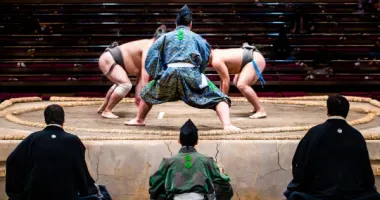In the footsteps of a traveler from the Edo period: stage 1 of Tokaido
Experiencing the Tokaido Route through the streets of Tokyo
Japan Experience offers you a detailed itinerary of the first stage of the Tokaido, the mythical road of the Edo period (1603-1868) , between the Nihonbashi bridge and the old Shinagawa relay, through the streets of Tokyo . Ready for a dive into the past?
A completely different setting, Tokyo of yesterday and today
Of the original Tokaidô route, almost nothing remains except for a few preserved portions, particularly in the Hakone region with the Hakone Kyu Kaido. Time and the urbanization of the archipelago have got the better of this ancestral route. Since Edo became Tokyo; processions of daimyos returning to their stronghold have given way to waves of salarymen on the sidewalks of the capital. The palanquins are no more than a distant memory; everyone now enjoys the speed and comfort of the capital's sprawling urban transportation network.
Those nostalgic for old times can rejoice. It is always possible to trample the Tokaido in the streets of Tokyo! This walk, 8 km long which largely follows the route of national road 15, can be done in 2 hrs. However, we advise you to devote a whole day to it as there are many sites to visit along the way. And that without even talking about shopping as you go through the very chic district of Ginza!
Starting point: Nihonbashi bridge (1)
The Nihonbashi Bridge, built in 1603 in the heart of Edo, is the starting point of the Gokaido, the five major roads of the archipelago. This zero kilometer point is also materialized by a stele (2) still visible at the northern end of the stone structure.
Throughout the Edo period (1603-1868), the bridge was used daily by the many surrounding merchants, official processions, and simple inhabitants. Initially made of wood, it was rebuilt in stone and steel in 1911 and then found itself partially concealed by an imposing expressway in the 1960s. A replica of the original bridge can be admired at the Edo-Tokyo Museum.
- Read also: The Gokaidô, the 5 historic roads of Japan
In the Nihonbashi district (3 to 4)
The Mitsukoshi establishment (3) in Nihonbashi, very close to the bridge, already existed in the Edo period under the name Echigoya Mitsui. It is quite simply the oldest department store in Tokyo. It thus appears on the 21st print of the series of "Thirty-six views of Mount Fuji" (1831-1833) by Hokusai. Founded in 1673 by fabric merchant, Takatoshi Mitsui, it has occupied its current location in Nihonbashi since 1683.
The Nishikawa Futon Company, established in Kyoto in 1566, opened a shop in Nihonbashi in 1615. Don't hesitate to push open the door of the four-hundred-year-old Nihonbashi Nishikawa (4) boutique! Then continue your route on the Chuo-dori towards Kyobashi for 1 kilometer.
In the Kyobashi district (5 to 6)
The Police Museum (5), which traces the history of the Japanese police from its inception to the present day, is on your left.
At the precise location of marker 6 stood in the Edo period the Kyobashi Bridge. Built in wood then rebuilt in stone during the Meiji period (1868-1612), the bridge was dismantled at the beginning of the Taishô era (1912-1926) due to the embankment of the river. From this last remains only a stone pillar installed on the right side of the road.
In the Ginza district (7 to 9)
The name Ginza comes from the Ginza Yakusho (government office) which operated during the Edo period. Very lively shops including large kimono shops lined the main street at the time.
Destroyed by the great fire of 1872, the district was rebuilt on a new urban model, inspired by the Western model, during the Meiji era. The British architect, Thomas James Waters, imagines wide cobbled roads and brick buildings; all lit by the height of modernity, gas street lamps. New stores equipped with storefronts and showcases are opening their doors.
This Western-style urban landscape makes Ginza (7) a pleasant district where people come to shop. This tradition of shopping has remained intact.
The district still brings together today a good number of luxury boutiques and major international brands (8).
Continuing your journey to the Ginza 4Chome intersection, you come across one of the iconic landmarks of the Ginza district: the luxury department store Wako (9), founded in 1881 by Kintaro Hattorien as a watch and jewelry store. A very popular store in the capital, the place is famous for its emblematic clock at the top. The current building in neo-classical style dates from 1932.
In the district of Shimbashi (10 to 14)
Continue your road for about 700 meters towards the Shimbashi district (10).
The first point of interest is none other than the station (11). Inaugurated in October 1872, Shimbashi station is one of the oldest stations in the archipelago. It is the terminus of the Tokaido line, the first railway line in the country, which connects the Japanese capital to Yokohama in 35 min.
Today, after dark, the station is the rallying point for neighborhood salarymen who frequent the many small bars and restaurants nestled under the tracks called gâdo shita.
Near the station, several monuments remind onlookers of the district's glorious past in the history of the capital's railways: a C11 292 (12) type steam locomotive, installed in 1972 on the square opposite the Hibiya exit of the station; to the left of the Shiodome exit, a stele (13) commemorating the railroad song Tetsudo Shoka, an extremely popular song written and performed in 1900 by Owada Takeki and faithful reconstruction of the original Shimbashi station which houses a museum (14) retracing the railway history of the district.

Locomotive installed in front of Shimbashi station
painreef3108
In the Shiodome district (15 to 21)
Continue on National Road 15 towards the Shiodome business district (15) where many Japanese companies have set up their headquarters. This is particularly the case of the Dentsu advertising agency, which moved into a 48-story building designed by the French architect Jean Nouvel in December 2002. The Dentsu Building (16), culminating at 213 meters in height, overlooks the Hama-rikyû garden (17) and its Nakajima-no-ochaya tea house.
After your stop at the Hama-rikyu garden; resume your itinerary on national road 15. On either side of the Daimon metro station (18), other emblematic monuments of the capital are worth a detour: on your left is the Kyu-Shiba Rikyu garden ( 19), one of the last gardens dating from the Edo period in Tokyo, and on your right, the Zojoji temple (20) where six shoguns of the Tokugawa clan are buried, which is located at the foot of the flamboyant Tokyo Tower (21), a broadcasting tower equipped with two observation platforms and built by architect Tachu Naito in 1958.
For the rest of the route, go to marker 22 then follow route 15 on the right.
Mizuno Kenmotsu Residence Ruins (23) and Sengaku-ji Temple (24)
The next two stages on this modern Tokaido route are directly linked to one of the most famous historical legends of the archipelago: the revenge of the 47 ronins. This one relates how 47 samurai foment their revenge after the death of their daimyô Naganori Asano, condemned to kill himself by seppuku in 1701 for having injured Yoshinaka Kira, the master of ceremonies of the house of the shogun who had insulted him.
In December 1702, guided by their leader Oishi Kuranosuke, the ronins put their plan into action. They kill Yoshinaka Kira and lay his head on their master's grave at Sengaku-ji Temple.
Arrested by the authorities, they are confined in four stately homes while awaiting the execution of their sentence; the death sentence by seppuku. Nine of them are placed in detention in the residence of the chief declan Mizuno Kenmotsu (23).
It is inside this residence that these ronins committed suicide by seppuku on February 4, 1703.
Of this villa, there remains today only a stone lantern and a statue of Jizo. Only a panel is there to remind us of this memorable part of Japanese history. A little over a kilometer further on is Sengaku-ji (24), which houses the tombs of Naganori Asano and his 47 samurai.
In the Shinagawa district (25 to 29)
The Shinagawa district is synonymous with good news: the journey is coming to an end! From Shinagawa station (25), the very first station in the archipelago, you only have one last kilometer left!
At marker 26, follow the road to your left and cross the bridge. Continue straight and cross the railway tracks. Then take on your right. Proceed towards another railway line that you will also have to cross. The rest of the route will be on the Kyu-Tokaido road.
By following the latter, you will pass not far from Kita-Shinagawa station (27).
About 200 meters after the station, you can treat yourself to a final little detour to go to a small monument dedicated to the Edo whale. Yes, you read that right! In 1798 following a violent typhoon, a whale ran aground in Edo Bay; thus attracting many curious people, including the shogun Tokugawa Ienari (1773-1841). A small funeral stele called "kujira-zuka" (28), engraved with a poem by Tani Sogai (1734-1823) and commemorating the sad fate of the cetacean, was built next to the Kagata-jinja.
This unusual anecdote is told by the mangaka Jirô Taniguchi in his book "Furari" inspired by the life of the surveyor and cartographer Inô Tadataka (1745-1818).
To finish this first stage of the Tokaidô road in the streets of Tokyo, return to the Kyu-Tokaido road. Your arrival point, Shinagawa-juku (29), is only a hundred meters away! A small park and a stone stele commemorate the location of the Shinagawa shukuba where travelers could stop and rest at an inn.
Although you have not traveled the road in a palanquin or trod the cobblestones of this ancestral road like in the Edo period, the satisfaction remains the same: you have completed the first stage of the Tokaido!
Address, timetable & access
Address
Timetable
1 min walk from Mitsukoshimae Subway Station, Tokyo Metro Ginza Line, or Hanzomon Line Exit B5 or B6
























































